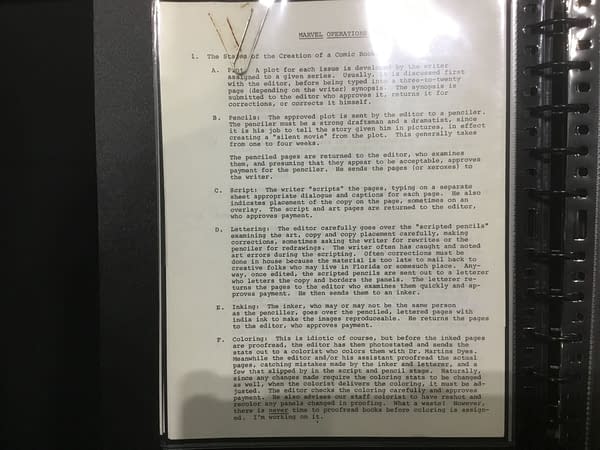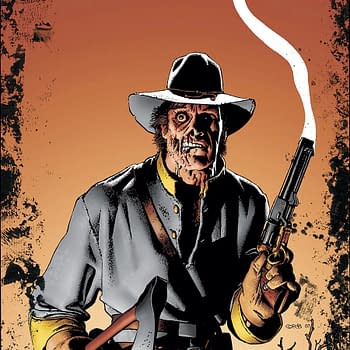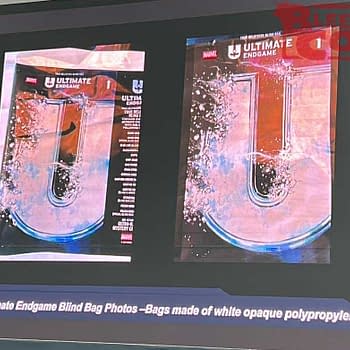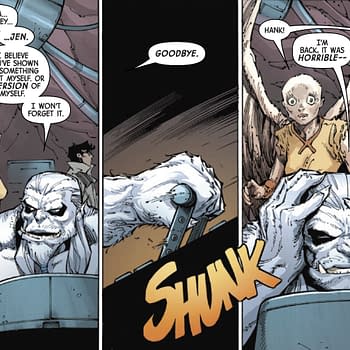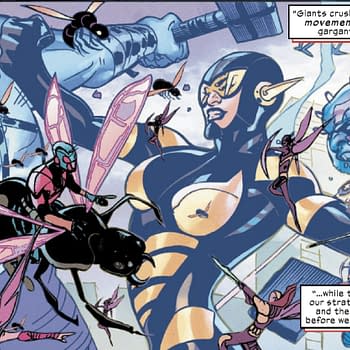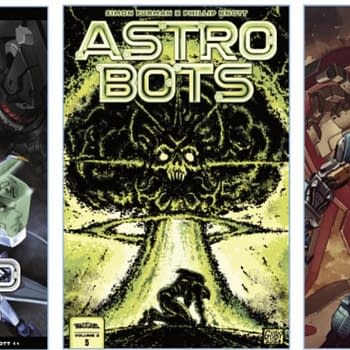Posted in: Comics, Marvel Comics | Tagged: Jim Shooter, Marvel Comics, shooterfiles
The Jim Shooter Files: The Six Stages of Creating A Comic Book – and the Idiotic Colouring Issues
Last month's MCM London Comic Con had Jim Shooter as a guest, and at his table were a number of folders, binders, full of memos, sketches, artwork from his long career at DC, Marvel, Valiant and more. He graciously allowed Bleeding Cool to take shots of a few of them, but these are just the tip of the iceberg of the folders he often brings to shows. But for Thanksgiving, Bleeding Cool will be sharing a few of them, and you can check the rest with this handy dandy tag.
In a series of memos, we can see some of former Marvel Editor-In-Chief Jim Shooter's approaches to the everyday work of publishing comic books. Starting with his stages of the creation of a comic book.
The Stages Of the Creation of a Comic Boook
A. A plot for each issue is developed by the writer assigned to a given series. Usually, this is discussed first with the editor, before being typed into a three-to-twenty page (depending on the writer) synopsis. The synopisis is submitted to the editor who approves it, corrections, or corrects it himself.
B Pencils: The approved plot is sent by the editor to a penciler. The penciler must be a strong draftsman and a dramatist, since it is his job to tell the story given him in pictures, in effect creating a "silent movie" from the plot. This generally takes from one to four weeks.
The penciled pages are returned to the editor, who examines them, and presuming that they appear to be acceptable, approves payment for the penciler. He sends the pages (or xeroxes) to the writer.
C. Script: The writer "scripts" the pages, typing on a separate sheet appropriate dialogue and captions for each page. He also indicates placement of the copy on the page, sometimes on an overlay. The script and art pages are returned to the editor, who approves payment.
D Lettering: The editor carefully goes over the "scripted pencils" examining the art, copy and copy placement carefully, making corrections, sometimes asking the writer for rewrites or the penciler for redrawings. The writer often has caught and noted art errors during the scripting. Often corrections must be done in house because the material is too late to mail back to creative folks who may live in Florida or somesuch place. Anyway, once edited, the scripted pencils are sent out to a letterer who letters the copy and borders the panels. The letterer re-turns the pages to the editor who examines them quickly and ap-proves payment. He then sends them to an inker.
E. Inking: The inker, who may or may not be the same person as the penciller, goes over the penciled, lettered pages with india ink to make the images reproduceable. He returns the pages to the editor, who approves payment.
F Coloring: This is idiotic of course, but before the inked pages are proofread, the editor has them photostated and sends the stats out to a colorist who colors them with Dr. Martins Dyes. Meanwhile the editor and/or his assistant proofread the actual pages, catching mistakes made by the inker and letterer, and a few that slipped by in the script and pencil stage. Naturally, since any changes made require the coloring stats to be changed as well, when the colorist delivers the coloring, it must be ad-justed. The editor checks the coloring carefully and approves payment. He also advises our staff colorist to have reshot and recolor any panels changed in proofing. What a waste! However, there is never time to proofread books before coloring is assigned. I'm working on it.
Looks like he did as well…


